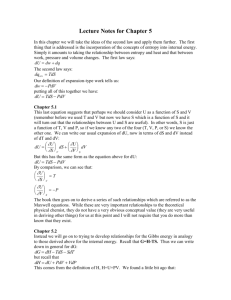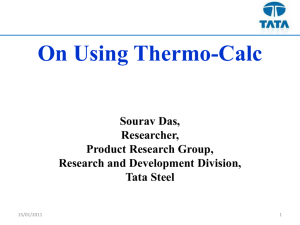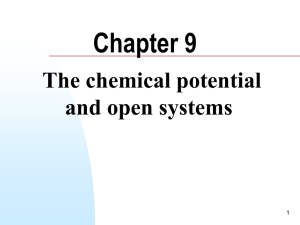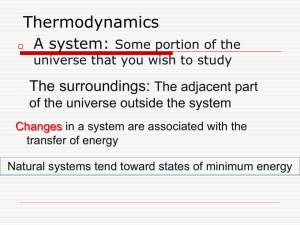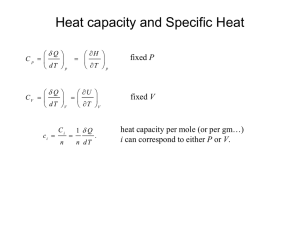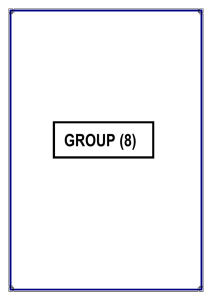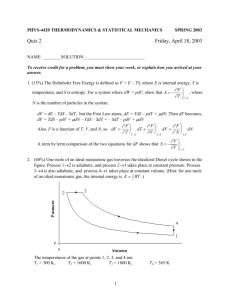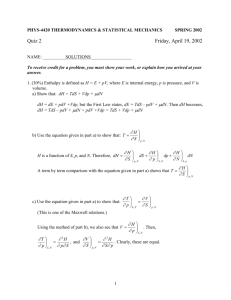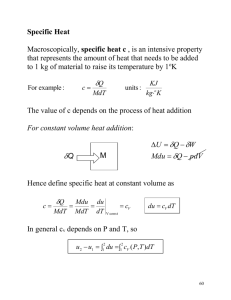Lecture 13. Thermodynamic Potentials (Ch. 5)
advertisement
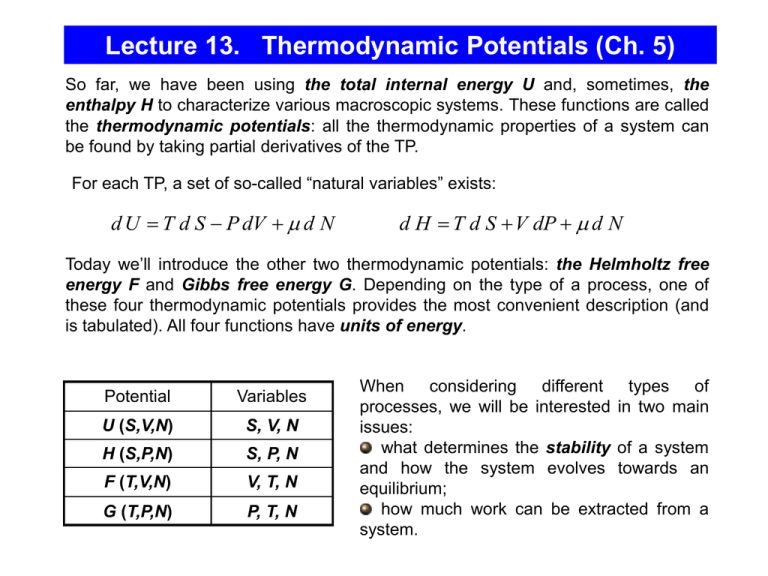
Lecture 13. Thermodynamic Potentials (Ch. 5) So far, we have been using the total internal energy U and, sometimes, the enthalpy H to characterize various macroscopic systems. These functions are called the thermodynamic potentials: all the thermodynamic properties of a system can be found by taking partial derivatives of the TP. For each TP, a set of so-called “natural variables” exists: d U T d S P dV d N d H T d S V dP d N Today we’ll introduce the other two thermodynamic potentials: the Helmholtz free energy F and Gibbs free energy G. Depending on the type of a process, one of these four thermodynamic potentials provides the most convenient description (and is tabulated). All four functions have units of energy. Potential Variables U (S,V,N) S, V, N H (S,P,N) S, P, N F (T,V,N) V, T, N G (T,P,N) P, T, N When considering different types of processes, we will be interested in two main issues: what determines the stability of a system and how the system evolves towards an equilibrium; how much work can be extracted from a system. Isolated Systems, independent variables S and V Advantages of U : it is conserved for an isolated system (it also has a simple physical meaning – the sum of all the kin. and pot. energies of all the particles). In particular, for an isolated system Q=0, and dU = W. Earlier, by considering the total differential of S as a function of variables U, V, and N, we arrived at the thermodynamic identity for quasistatic processes : dU S ,V , N TdS PdV dN The combination of parameters on the right side is equal to the exact differential of U . This implies that the natural variables of U are S, V, N, Considering S, V, and N as independent variables: U U U dS dV dN dU ( S ,V , N ) S V N V , N S ,N S ,V Since these two equations for dU must yield the same result for any dS and dV, the corresponding coefficients must be the same: U T S V , N U P V S ,N U N S ,V Again, this shows that among several macroscopic variables that characterize the system (P, V, T, , N, etc.), only three are independent, the other variables can be found by taking partial derivatives of the TP with respect to its natural variables. Equilibrium in Isolated Systems UA, VA, SA UB, VB, SB For a thermally isolated system Q = 0. If the volume is fixed, then no work gets done (W = 0) and the internal energy is conserved: U const While this constraint is always in place, the system might be out of equilibrium (e.g., we move a piston that separates two sub-systems, see Figure). If the system is initially out of equilibrium, then some spontaneous processes will drive the system towards equilibrium. In a state of stable equilibrium no further spontaneous processes (other than ever-present random fluctuations) can take place. The equilibrium state corresponds to the maximum multiplicity and maximum entropy. All microstates in equilibrium are equally accessible (the system is in one of these microstates with equal probability). S eq max This implies that in any of these spontaneous processes, the entropy tends to increase, and the change of entropy satisfies the condition dS 0 Suppose that the system is characterized by a parameter x which is free to vary (e.g., the system might consist of ice and water, and x is the relative concentration of ice). By spontaneous processes, the system will approach the stable equilibrium (x = xeq) where S attains its absolute maximum. S xeq x Enthalpy (independent variables S and P) The volume V is not the most convenient independent variable. In the lab, it is usually much easier to control P than it is to control V. To change the natural variables, we can use the following trick: Legendre Trans.: U S ,V U S , P PV dH d U PV dU PdV VdP dU T dS PdV dH TdS VdP dH S , P, N T dS VdP dN H (the enthalpy) is also a thermodynamic potential, with its natural variables S, P, and N. - the internal energy of a system plus the work needed to make room for it at P=const. The total differential of H in terms of its independent variables : H H H dH S , P, N dS dP dN S P , N P S , N N S , P H T S P , N Comparison yields the relations: H V P S , N In general, if we consider processes with “other” work: H N S , P dH TdS VdP Wother Processes at P = const , Wother = 0 At this point, we have to consider a system which is not isolated: it is in a thermal contact with a thermal reservoir. dH TdS VdP Wother Q VdP Wother Let’s consider the P = const processes with purely “expansion” work (Wother = 0), dH P ,W other 0 Q For such processes, the change of enthalpy is equal to the thermal energy (“heat”) received by a system. Q H CP T P T P For the processes with P = const and Wother = 0, the enthalpy plays the same part as the internal energy for the processes with V = const and Wother = 0. Example: the evaporation of liquid from an open vessel is such a process, because no effective work is done. The heat of vaporization is the enthalpy difference between the vapor phase and the liquid phase. Systems in Contact with a Thermal Reservoir There are two complications: (a) the energy in the system is no longer fixed (it may flow between the system and reservoir); (b) in order to investigate the stability of an equilibrium, we need to consider the entropy of the combined system (= the system of interest+the reservoir) – according to the 2nd Law, this total entropy should be maximized. What should be the system’s behavior in order to maximize the total entropy? Stotal S system Sreservoir Reservoir R UR - Us System S Us Helmholtz Free Energy (independ. variables T and V) Let’s do the trick (Legendre transformation) again, now to exclude S : U S ,V U T ,V T S F U T S d U TS TdS PdV SdT TdS SdT PdV dF T ,V , N SdT PdV dN The natural variables for F are T, V, N: F F F dF T ,V , N dT dV dN T V , N V T , N N T ,V F S T V , N F P can be rewritten as: V T , N F P V T , N F N T ,V F U S P T V T , N V T , N V T , N The first term – the “energy” pressure – is dominant in most solids, the second term – the “entropy” pressure – is dominant in gases. (For an ideal gas, U does not depend on V, and only the second term survives). The Minimum Free Energy Principle (V,T = const) U U R U s , U R Us N , V of both are fixed S R s U R ,U s S R U U s S s U s max Reservoir R UR - Us System S Us system’s parameters only F U S S R s U , U s S R U R U s S s U s S R U s S s S R U s T U T SR+s reservoir +system Us Fs loss in SR due to transferring Us to the system dS R s U ,U s dS s system stable equilibrium Us dS R s dFs T gain in Ss due to transferring Us to the system dU s 1 dU s TdS s T T Fs min Processes at T = const In general, if we consider processes with “other” work: For the processes at T = const (in thermal equilibrium with a large reservoir): dF SdT PdV Wother dF T PdV Wother T The total work performed on a system at T = const in a reversible process is equal to the change in the Helmholtz free energy of the system. In other words, for the T = const processes the Helmholtz free energy gives all the reversible work. Problem: Consider a cylinder separated into two parts by an adiabatic piston. Compartments a and b each contains one mole of a monatomic ideal gas, and their initial volumes are Vai=10l and Vbi=1l, respectively. The cylinder, whose walls allow heat transfer only, is immersed in a large bath at 00C. The piston is now moving reversibly so that the final volumes are Vaf=6l and Vbi=5l. How much work is delivered by (or to) the system? The process is isothermal : UA, VA, SA UB, VB, SB For one mole of monatomic ideal gas: The work delivered to the system: dF T PdV T Va f Vb f Va i Vb i W Wa Wb dFa dFb 3 3 T V F U TS RT RT ln RT ln Tf ( N , m) 2 T0 V0 2 Vaf Vbf W RT ln RT ln 2.5 103 J Vai Vbi Gibbs Free Energy (independent variables T and P) Let’s do the trick of Legendre transformation again, now to exclude both S and V : U S ,V U T , P T S PV G U T S PV - the thermodynamic potential G is called the Gibbs free energy. Let’s rewrite dU in terms of independent variables T and P : dU TdS PdV d (TS ) SdT d PV VdP d U TS PV SdT VdP dGT , P, N SdT VdP dN Considering T, P, and N as independent variables: Comparison yields the relations: G G G dGT , P, N dT dP dN T P N P, N T , N T , P G S T P, N G V P T , N G N T , P Gibbs Free Energy and Chemical Potential G G T , P, N & extensive: bG T , P, N G T , P, bN G N b is a arbitary constant. - this gives us a new interpretation of the chemical potential: at least for the systems with only one type of particles, the chemical potential is just the Gibbs free energy per particle. The chemical potential G G N T ,P N If we add one particle to a system, holding T and P fixed, the Gibbs free energy of the system will increase by . By adding more particles, we do not change the value of since we do not change the density: (N). Note that U, H, and F, whose differentials also have the term dN, depend on N nonlinearly, because in the processes with the independent variables (S,V,N), (S,P,N), and (V,T,N), = (N) might vary with N. Example: Pr.5.9. Sketch a qualitatively accurate graph of G vs. T for a pure substance as it changes from solid to liquid to gas at fixed pressure. G S T P , N - the slope of the graph G(T ) at fixed P should be –S. Thus, the slope is always negative, and becomes steeper as T and S increases. When a substance undergoes a phase transformation, its entropy increases abruptly, so the slope of G(T ) is discontinuous at the transition. G solid liquid gas T S G S T P G ST - these equations allow computing Gibbs free energies at “non-standard” T (if G is tabulated at a “standard” T) solid liquid gas T The Minimum Free Energy Principle (P,T = const) S R s U R ,U s S R U U s S s U s max dS R s U , U s dS s SR+s Gs reservoir +system Us system stable equilibrium Us dU s P dG 1 dVs dU s TdS s PdVs s T V T T Under these conditions (fixed P, V, and N), the maximum entropy principle of an isolated system is transformed into a minimum Gibbs free energy principle for a system in the thermal contact + mechanical equilibrium with the reservoir. dG T , P , N 0 G min Thus, if a system, whose parameters T,P, and N are fixed, is in thermal contact with a heat reservoir, the stable equilibrium is characterized by the condition: G/T is the net entropy cost that the reservoir pays for allowing the system to have volume V and energy U, which is why minimizing it maximizes the total entropy of the whole combined system. Processes at P = const and T = const Let’s consider the processes at P = const and T = const in general, including the processes with “other” work: Then W PdV Wother dG d U T S PV T , P Q PdV Wother T , P TdS PdV Q T , P Wother T , P TdS Wother T , P The “other” work performed on a system at T = const and P = const in a reversible process is equal to the change in the Gibbs free energy of the system. In other words, the Gibbs free energy gives all the reversible work except the PV work. If the mechanical work is the only kind of work performed by a system, the Gibbs free energy is conserved: dG = 0. Gibbs Free Energy the Spontaneity of Chemical Reactions Maxwell relation T.P. are state functions, i.e. cross derivatives are equal. e.g. dU TdS PdV dN U U T P V V S S V S ,N S V , N T P similarly, , N S ,V S V , N N S ,V V S , N More in Problem 5.12 Summary Potential Variables U (S,V,N) S, V, N H (S,P,N) S, P, N F (T,V,N) V, T, N G (T,P,N) P, T, N dU S ,V , N T dS PdV dN dH S , P, N T dS VdP dN dF T ,V , N S dT PdV dN dGT , P, N S dT VdP dN T P Maxwell relation: , V S , N S V , N

